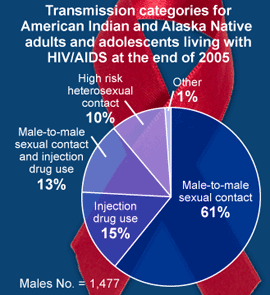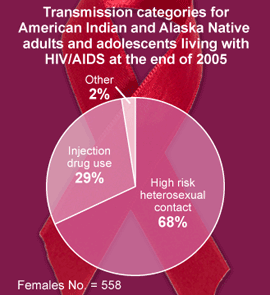Data & Statistics
Featured Data & Statistics


National Native HIV/AIDS Awareness Day 2008
Thursday, March 20, 2008 is National Native (American Indian, Alaska Native, and Native Hawaiian) HIV/AIDS Awareness Day (NNHAAD). Even though the numbers of HIV and AIDS diagnoses for American Indians and Alaska Natives represent less than 1% of the total number of HIV/AIDS cases reported to CDC’s HIV/AIDS Reporting System, when population size is taken into account, American Indians and Alaska Natives in 2005 ranked 3rd in rates of HIV/AIDS diagnosis, after blacks (including African Americans) and Hispanics [1].
HIV/AIDS in 2005
• The estimated rate (per 100,000) of AIDS diagnosis for American Indian and Alaska Native adults and adolescents was 9.3, the 3rd highest after the rates for black adults and adolescents (68.7) and Hispanic adults and adolescents (24.0). The estimated AIDS diagnosis rate was 6.9 for white adults and adolescents and 4.3 for Asian and Pacific Islander adults and adolescents [1].
• AIDS was diagnosed for an estimated 182 American Indians and Alaska Natives, representing approximately 0.4% of all AIDS diagnoses in 2005 [1]. These data include persons whose HIV infection had been diagnosed earlier.
• An estimated 1,581 American Indians and Alaska Natives were living with AIDS [1].
• An estimated 81 American Indians and Alaska Natives with AIDS died in 2005, representing approximately 0.5% of all deaths of persons with AIDS for that year [1].
• From the beginning of the epidemic through 2005, AIDS was diagnosed for an estimated 3,238 American Indians and Alaska Natives [1].
• From the beginning of the epidemic through 2005, an estimated 1,657 American Indians and Alaska Natives with AIDS had died [1]. In comparison, 235,879 whites, 211,559 blacks, 77,125 Hispanics, and 3,383 Asians and Pacific Islanders with AIDS had died.
• Of persons who had received a diagnosis of AIDS during 1997– 2004, American Indians and Alaska Natives had survived for a shorter time than had Asians and Pacific Islanders, whites, or Hispanics. After 9 years, 67% of American Indians and Alaska Natives were alive, compared with 66% of blacks, 74% of Hispanics, 75% of whites, and 81% of Asians and Pacific Islanders [1].
• From the beginning of the epidemic through 2005, AIDS had been diagnosed for an estimated 32 American Indian and Alaska Native children (younger than 13 years) [1].
Data References
1. CDC. HIV/AIDS Surveillance Report, 2005. Vol. 17. Rev ed. Atlanta: US Department of Health and Human Services, CDC: 2007:1–46. Accessed June 28, 2007.
Data Source: CDC. Fact Sheet: HIV/AIDS among American Indians and Alaska Natives. June 2007
For More Information:
- CDC HIV/AIDS
CDC's Web site for HIV/AIDS in the United States - National Native HIV/AIDS Awareness Day
U.S. Department of Health and Human Services - CDC National Prevention Information Network (NPIN)
The US reference, referral, and distribution service for information on HIV/AIDS, sexually transmitted diseases (STDs), and tuberculosis (TB)

CDC Fact Sheet: HIV/AIDS among American Indians and Alaska Natives
Data shows that HIV/AIDS is a growing problem among American Indians and Alaska Natives.

National HIV Testing Database
Find an HIV test site near your from the National HIV Testing Database, a CDC-sponsored service available 24 hours a day.
Page last reviewed: March 19, 2008
Page last updated: March 19, 2008
Content source: National Center for HIV/AIDS, National Center for HIV/AIDS, Viral Hepatitis, STD, and TB Prevention
Content owner: National Center for Health Marketing
URL for this page: http://www.cdc.gov/features/dsNativeHIVAIDS
